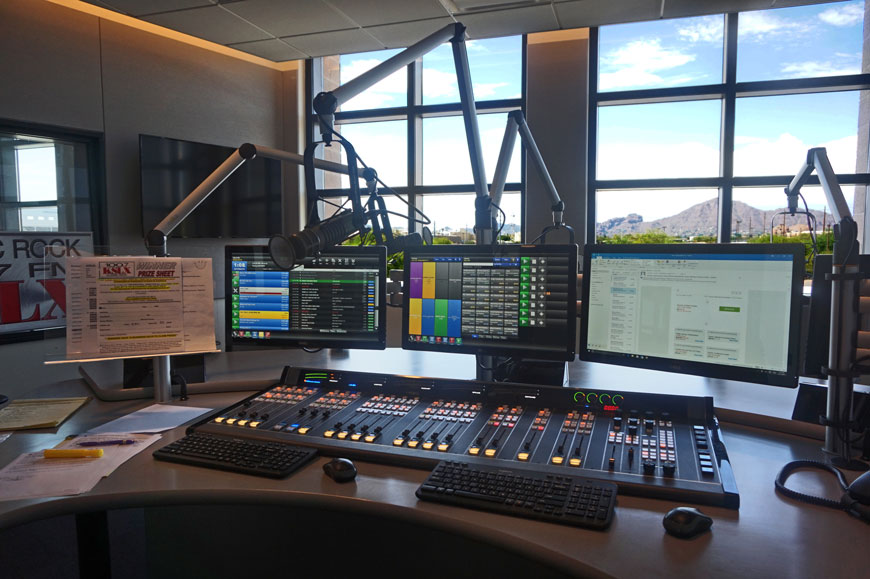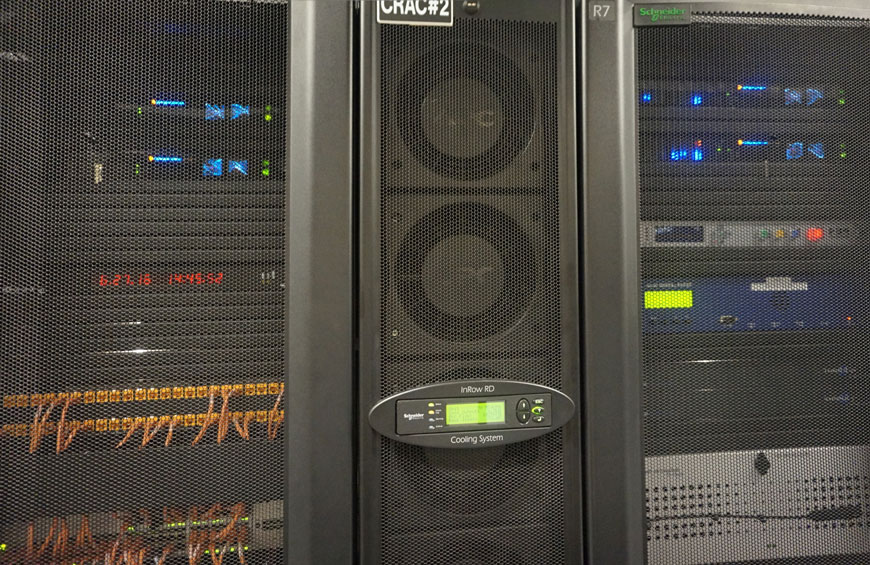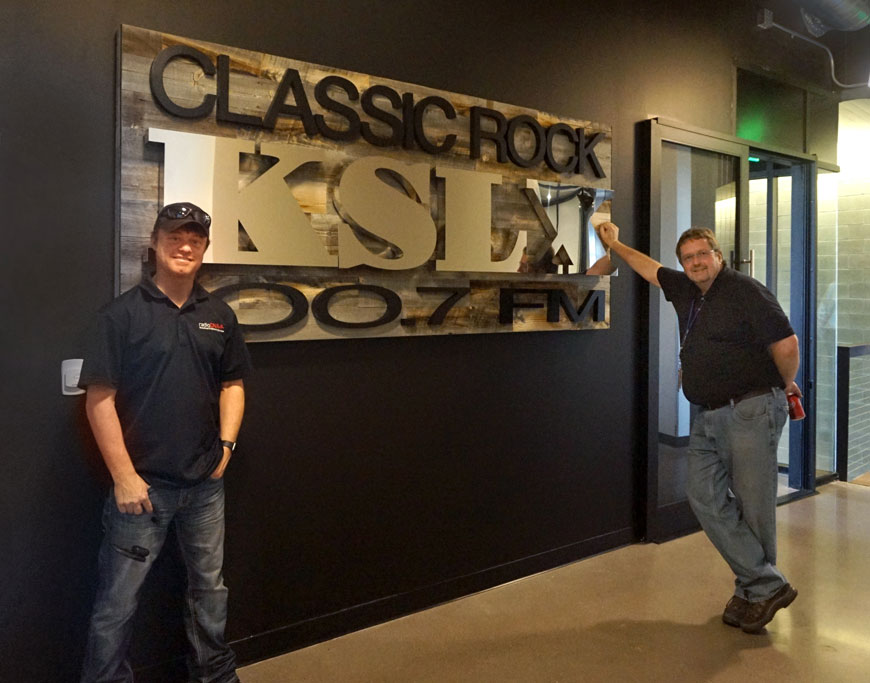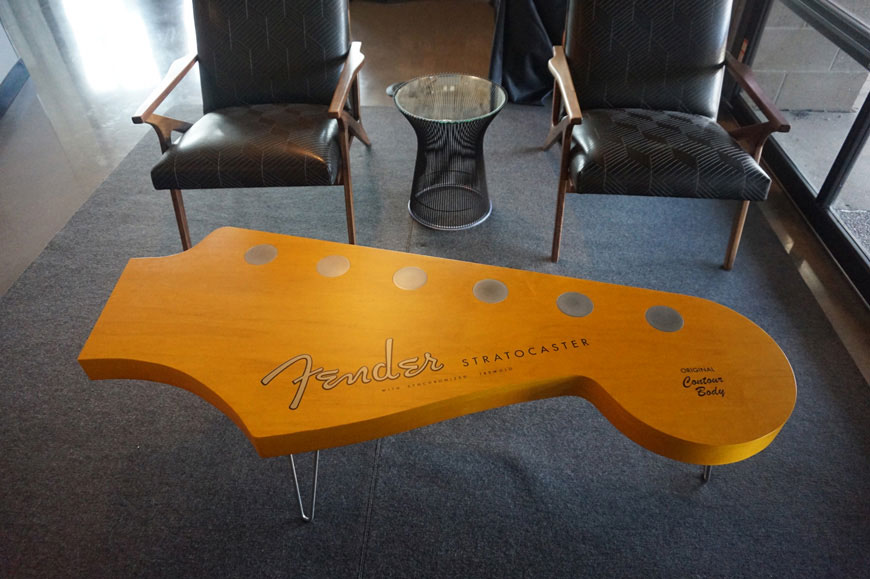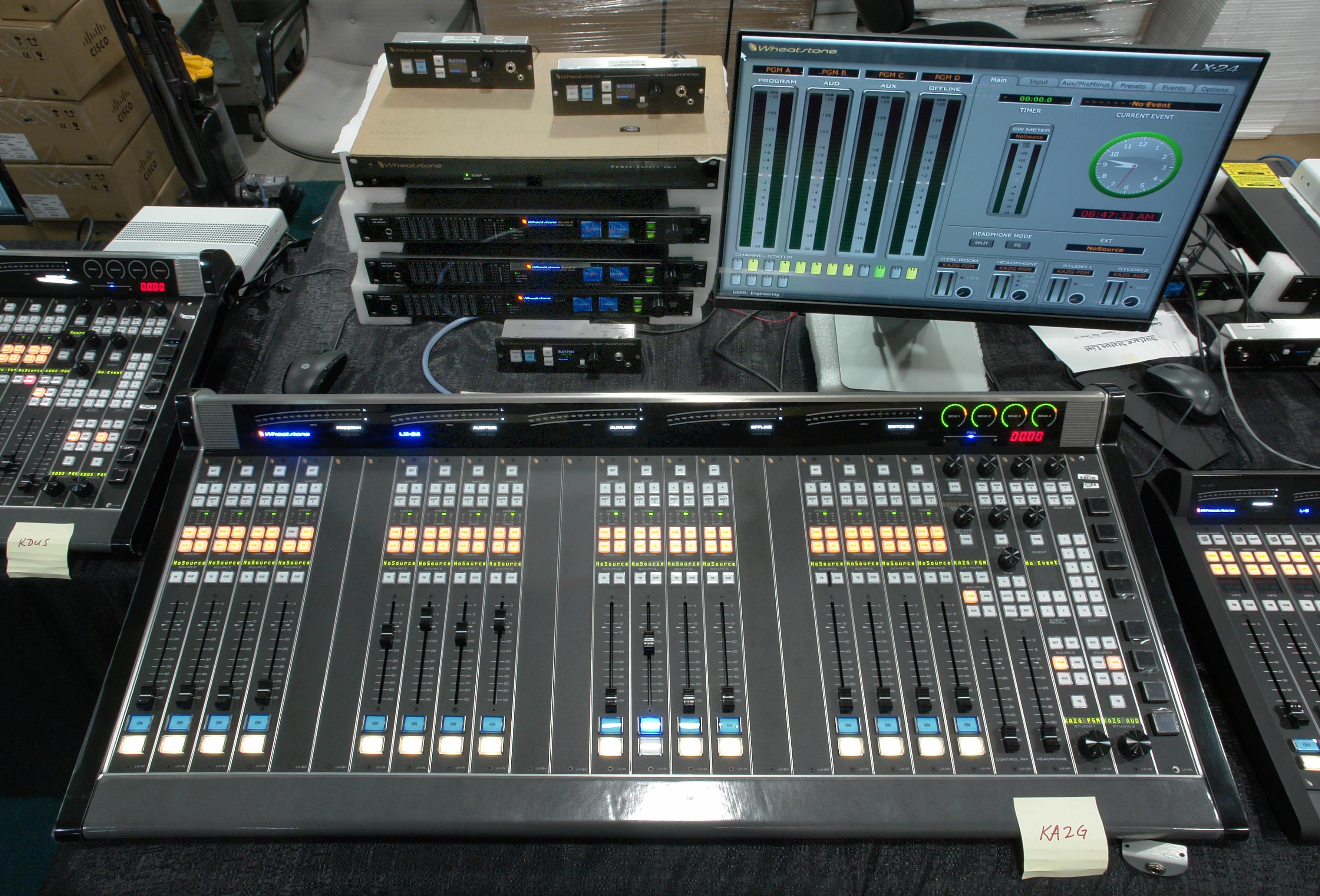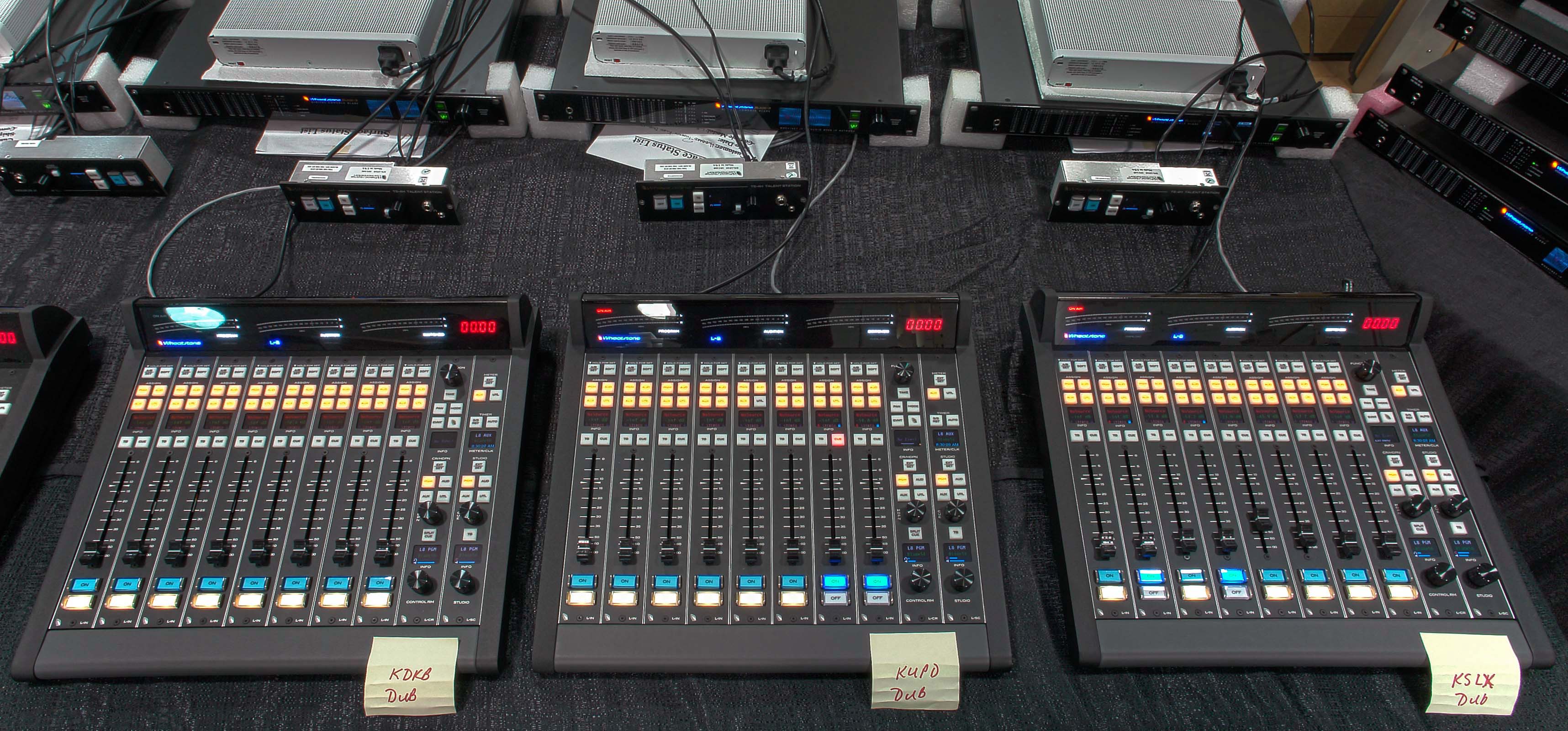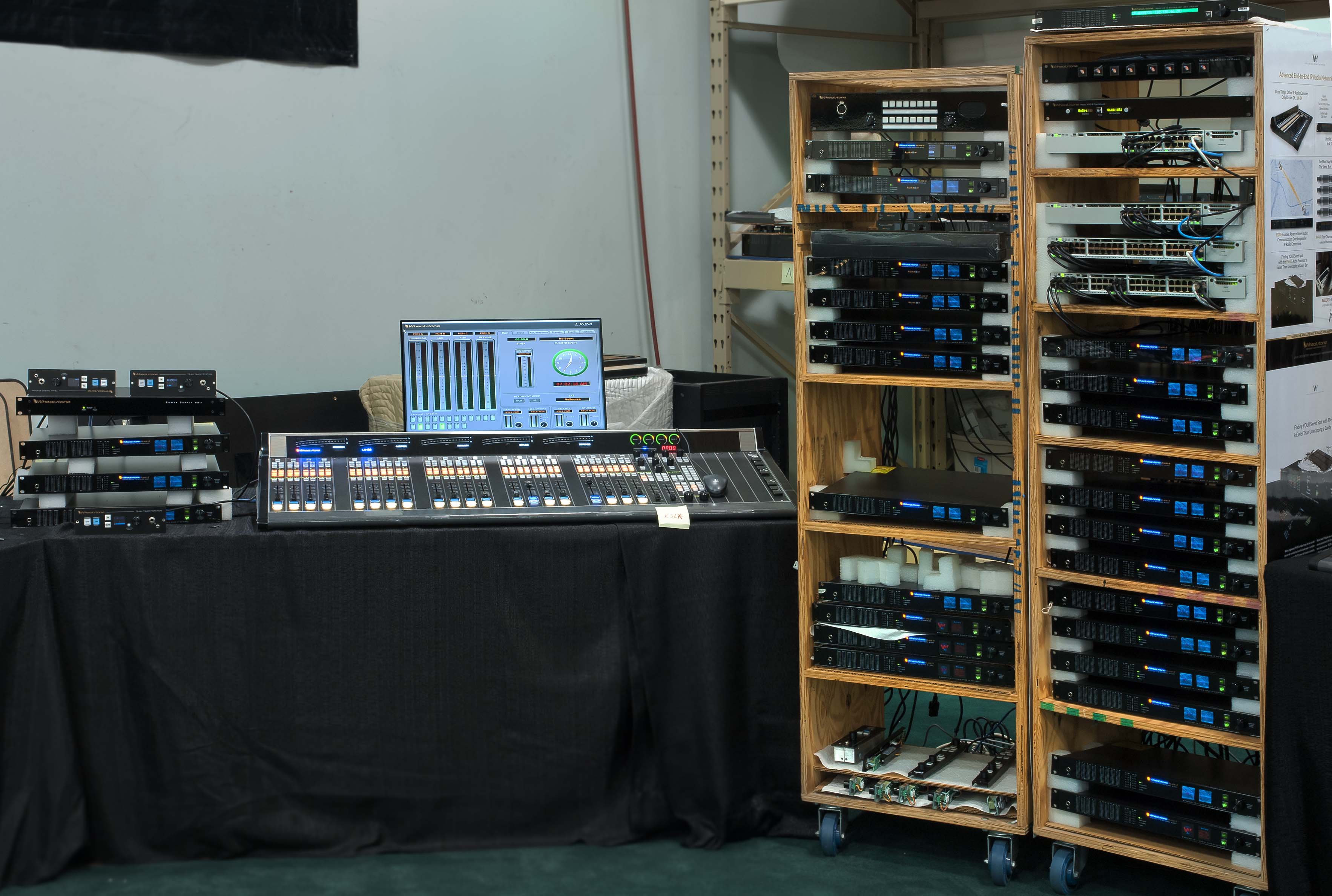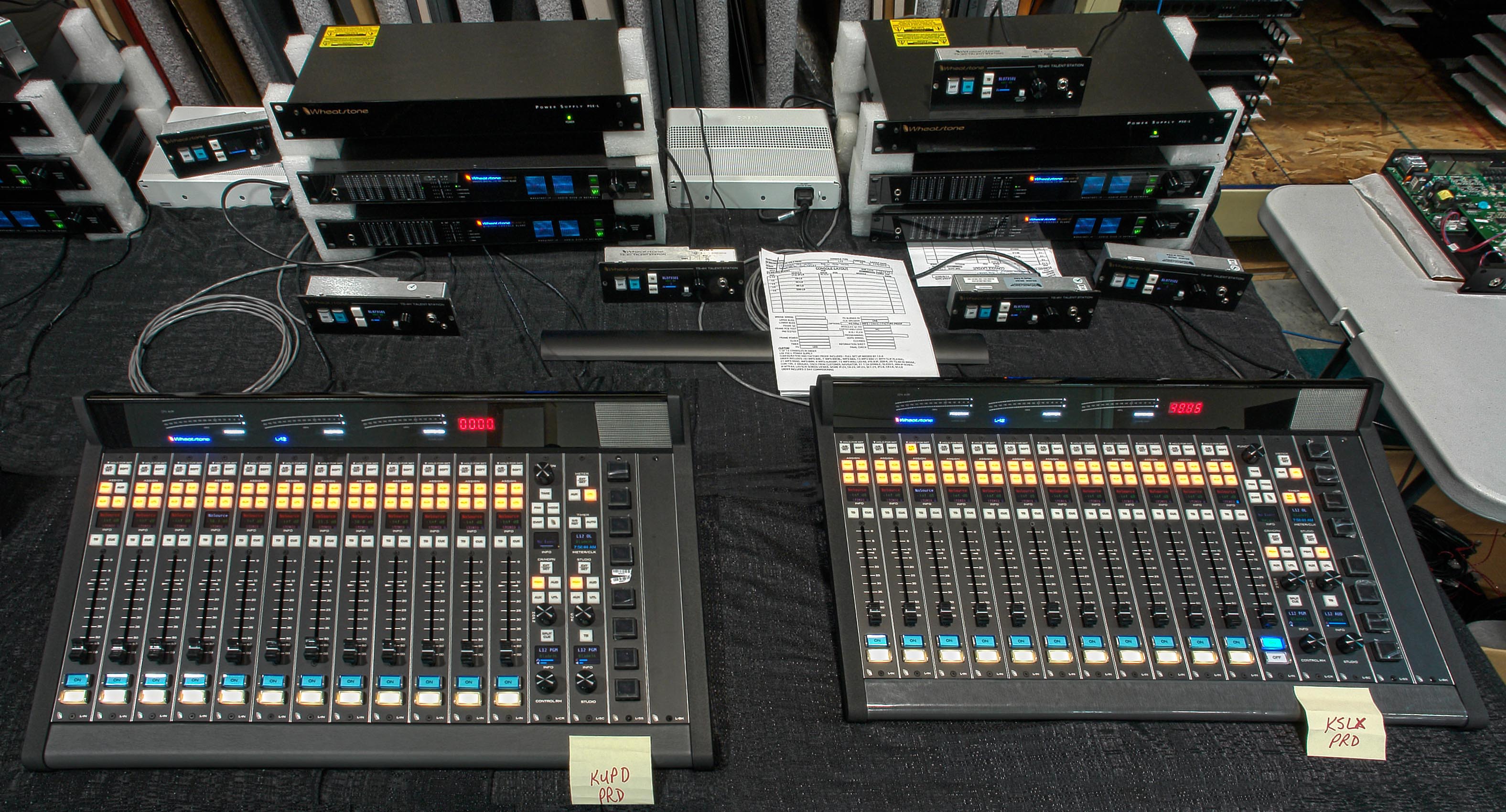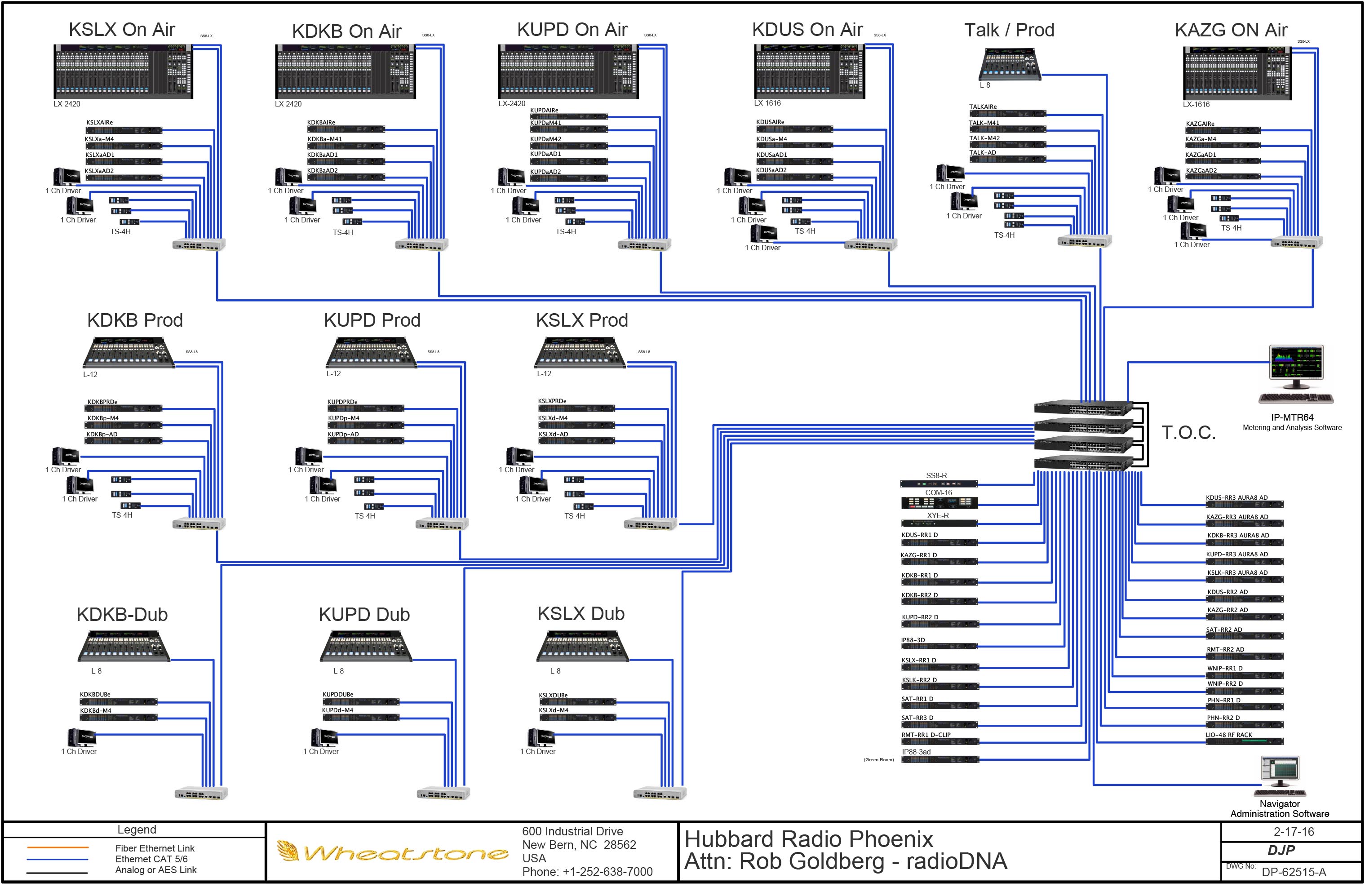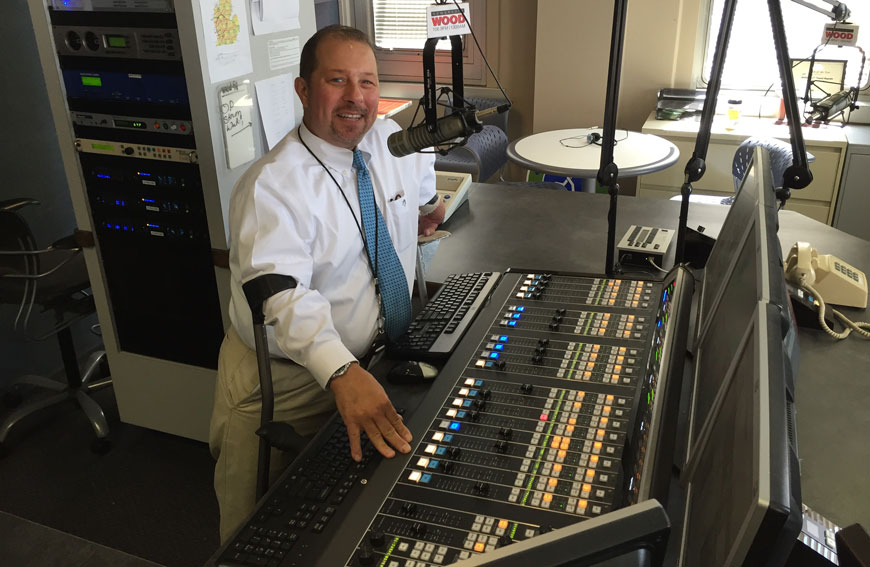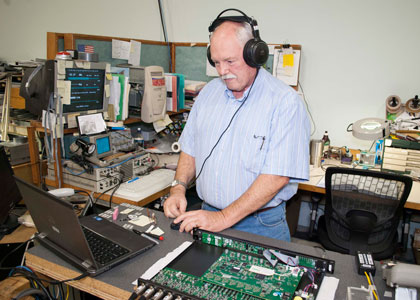WHEAT:NEWS RADIO
JULY 2016 - Vol 7, No.7
Got feedback or questions? Click my name below to send us an e-mail. You can also use the links at the top or bottom of the page to follow us on popular social networking sites and the tabs will take you to our most often visited pages.
Hot New Studio Ideas from Phoenix
by Dee McVicker
Maybe it was the air conditioning, but I noticed I said “cool” more than usual during my visit to Hubbard Radio’s new studio facility in Phoenix, Arizona, last month.
In my defense, there were a lot of new and interesting things to look at, starting with the chillers in the rack room. “This turned out to be one of our smarter ideas because so often we’re just blowing air around the room and what we really need is cooling where the gear is,” said RadioDNA’s Rob Goldberg, who was brought in as the integrator on the 13-studio, 28,000 square-foot-facility and could barely be heard over the AC – a familiar sound in Phoenix in June.
Hubbard Radio installed rackmount AC units, or what I later learned were called CRACs (for Computer Room Air Conitioners) in every third or fourth rack. These chillers are essentially compact evaporative coolers that suck in the exhaust air from rack gear, water cool it, and blow the result out the front of the rack. Temperature sensors inside the racks regulate airflow, and any exhaust goes into a cavity at the back of the rack, where it is cooled by coils and circulated.
“We couldn’t ask for a better test market,” commented Rob, who had spent the better part of the spring and into the summer in Phoenix dealing with layout, cabling and issues like equipment cooling.
Hubbard Radio installed chillers called CRACs, or what are essentially compact evaporative coolers, in every third or fourth rack in the rack room to keep equipment cool.
The day I was there, the temperature hit 108 and Rob and his team from Minneapolis were finishing up with details and hoping to catch the next flight out for home. New CE Dave Adkins, who was hired on mid-project, was taking over the operation from Rob and looking like he wouldn’t mind planning a trip out of Phoenix away from the heat sometime soon.
We spent quite a bit of time going through each of the studios for stations KSLX-FM, KUPD-FM, KDKB-FM and KDUS-AM and KAZG–AM, which were brought together under one roof for the first time as a result of the move to the new facility on 52nd street. I know personally how fiercely independent each of those brands are, having lived in Phoenix for most of my life and having more than a passing understanding of the differences between, say, classic rocker KSLX-FM and hard-hitting rocker KUPD-FM. I wondered how everyone was getting along now that they shared the same address. “They are each very separate entities, and that doesn’t seem to have changed. The difference is they can now share resources so much easier because they’re connected through the WheatNet,” replied Rob.
Having all stations together on one floor created efficiencies and greater synergy where there were none before. And, just as important, according to Hubbard Radio’s Phoenix Market Manager Trip Reeb, “It means I don’t have to drive all over town anymore.”
It helps that studios share the same console makes and models (LX-24s in the main, L-12s in side studios), so any jock can punch up his profile settings on any board and feel right at home. Studios had more TS-4 talent stations than I remember seeing anywhere, and these too are networked in and also have USB connectivity conveniently located on the side for guest laptops and the like. Wheatstone built a case with USB jack at each talent station that is wired back to the M4 four-channel mic processor through a USB port -- a cool idea Rob suggested to our guys while at the Wheat factory during system staging. The M4 now comes with USB, and this is one more example of teamwork between station, integrator and factory.
A couple of really cool guys, RadioDNA’s Rob Goldberg, left, and Hubbard Radio’s new Phoenix CE Dave Adkins.
Something else I noticed starting in the rack room and throughout the facility was lighting in some rather unusual places. Rob is known for putting lighting in racks, cabinets and other out-of-the-way spaces. His point: engineers go to a lot of trouble to color code cabling, but if they can’t see, what good is that? Good point.
Other cool ideas that caught my eye were speakers recessed into the ceilings of studios, pigtail cabling and roll-around cabinets. Oh, and I thought Rob’s use of the audio processors built into our I/O BLADE-3s for off-air pre-checks was pretty darn cool. “Processing is already integrated into those network units, so I can route audio to headphones and in the speakers,” said Rob, who was able to bypass the ordeal of having to hunt down unused older processors that he’d then have to cannibalize in order to remove the pre-emphasis.
The cool just kept on coming at every turn.
Apparently, the Fender contingent had already toured Hubbard Radio’s new Phoenix digs, judging by the amps and guitars and this Strat coffee table in the lobby.
The downstairs digital media room where staff were brainstorming ideas on a large wall white board had me practically chanting “cool,” as did the upstairs soon-to-be green room that will be networked into all the studios for house video production use. A promenade for visiting artists was beyond cool. And, the Fender guitars, Strat coffee table and staircase of Fender amps in the lobby – trés cool (I’m a big Fender fan, not that I can actually strum a guitar, but because my husband is an audio engineer for Fender).
I was genuinely impressed with my hometown stations, even the documentation. Nothing’s cooler than documentation that lays out wire management, network drops, sources, how signals propagate throughout, and everything, right down to the names of salvos. “I like to do a lot of planning upfront, so there are no surprises later,” said Rob.
Cool.
One-Armed Board Op
Running an audio board is like playing the piano. It helps to have full use of both arms. Yet, for 35 years, Phil Tower has managed to find his way around most radio consoles with one arm as an on-air personality for some fairly competitive stations. He was born with a congenital birth defect that reduced his left arm to half the normal size, which meant he lunged halfway across the board to hit the on-air button with his good arm for most of his career.
Then, iHeartMedia rolled in the LX-24 control surface as part of an IP audio conversion of its studios in West Michigan, where Tower is the PD and fill-in talent for news/talk WOOD-AM/FM. The 24-fader IP control surface replaced the group’s analog boards in its seven-station facility and, as Tower tells it, it didn’t take long before he was talking to engineering about configuring the LX-24 as a more righthand friendly board.
“I had gotten used to adapting. But when iHeartMedia West Michigan IT Manager Marc Hill told me we could assign different things to different channels, and that we could configure it so that everything is on the right, I thought, ‘Wow. That’s going to make life a lot easier.”
Which, predictably, it has.
Now, as soon as Tower sits down to the LX-24 in the WOOD-AM/FM control room, he immediately punches up his profile settings. Mics and Prophet/Wizard automation feeds automatically switch to faders on the right side of the board, where he has quick access to talkback and weather or traffic beds using his good arm. Most important, the on-air button is just a finger’s reach up from where his right hand normally rests on the board. All faders, controls and knobs to the left are set up for non-essentials.
Tower, who started in radio long before the American Disabilities Act, records mainly public affairs interviews and does the occasional fill-in for the AM’s news and talk shows. He’s also responsible for hiring entry-level on-air talent. “If my minor modifications can help me, my hope is that modifications in really essential boards like the Wheatstone will help people with even greater disabilities,” he comments.
“We’re a very accommodating industry to a point, but no one’s going to hire a separate board op for talent,” says Marc Hill, the IT Manager for iHeartMedia West Michigan’s cluster, who configured profiles for the IP audio board and created salvos and macros for triggering commands used in the cluster’s WheatNet-IP audio network.
Tower hopes to be an example to others, or at the least an inspiration. “I think people look at me now and think, ‘Well, if he can do all that with one arm I guess I better at least learn to run the board.’”
Where Do Broadcast Engineers Come From?
Broadcasters aren’t born. They’re made, and according to SBE President Jerry Massey, no one makes them better than the U.S. military. “We see every day the military is releasing very qualified individuals who have good training in both IT and RF,” he says.
The military has long been a resource for recruiting broadcast engineers because of the military’s specialized training in RF. Now, with renewed concerns about where the industry will get its next generation of broadcast engineers, SBE is once again pointing to the military as a source for qualified engineers knowledgeable in not only RF, but IP as well.
“RF isn’t going to go away anytime soon, but we all know that anything dealing with RF now has an Ethernet port on it, so the two combined present a challenge to fill opportunities in broadcasting,” explains Massey. He says the SBE is planning to eventually introduce a military recruitment program to entice qualified military personnel to become members of the broadcast industry.
The SBE is known for its leadership in broadcast engineering education and certification.
Register for VoxPro Academy
Wheatstone is proud to announce VoxPro Academy - a series of hands on workshops designed to present techniques, demonstrate the new features in VoxPro6, and give folks a look at what others in the industry are doing with VoxPro.
VoxPro Academy will be held at times to coordinate with different trade shows across the country and around the world.
Wheat Support to Parts Unknown
Even after 18 years on the job as a repair technician in the Wheatstone factory, Jack Cosgrove still runs into the odd Wheatstone product he never knew existed. “I’ve never actually seen an 8X console, but I know they’re out there because I’ve worked on a replacement module for one,” he says.
Over the past two decades, he’s seen just about every console, network unit, audio processor and equalizer ever made by Wheatstone. That’s because virtually every Wheatstone product ever manufactured is still supported in our factory in New Bern, NC (and some others as well, like the VoxPro line we acquired last year).
Read the entire story
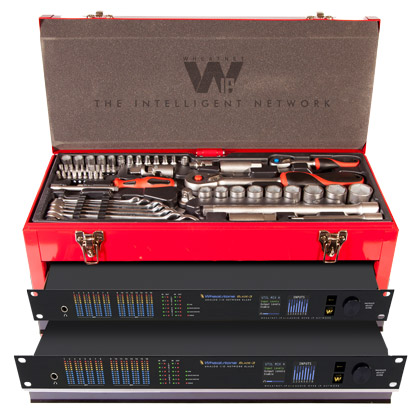
Your IP Question Answered
Q: How reliable is IP audio networking?
A: Reliability used to be one of those things that came up often 15 years ago when IP audio networking was relatively new. These days, it’s a nonissue, not only because IP technology has become more reliable overall, but also because of how manufacturers design their systems for the broadcast environment. For example, our WheatNet-IP audio network distributes intelligence and resources throughout the network. This automatically builds in redundancy, so if one part of the network fails for any reason, the rest can keep on functioning. In addition, because each IP connection point – or I/O BLADE – stores the entire configuration of the network onboard, failover is accurate and immediate. Most broadcast studios today run some aspect of their critical operations using IP technology with very little difficulty.
Wheatstone Interviews the Broadcast Industry: Minister of Algorithms Steve Dove
At this year's NAB show, we invited many people from all corners of the industry to join us in conversations about all things broadcast. Obviously, we focused on audio for broadcast because, well, it's what we know.
We didn't really know what to expect, but the results definitely exceeded even our greatest expectations. We touched on many, many subjects and heard some fascinating things about what people are doing with audio in the broadcast world. Each of these videos is a wealth of information spanning every aspect of audio for broadcast.
In this video, Scott Fybush talks to Steve Dove, Wheatstone's legendary Minister of Algorithms, about how he got started with DSP, some of the reasons we use it to emulate older gear, and what's on the horizon for processing.

Wheatstone
-
WJAX-TV (Jacksonville, FL) added an E-6 control surface to an existing WheatNet system.
-
Elon University (Elon, NC) purchased two Series Four television audio consoles and one LX-24 control surface through Digital Video Group.
-
AP News (New York, NY) purchased an LX-24 control surface through Diversified Systems.
-
Brighthouse Networks (St. Petersburg, FL) purchased a de-embedder cage for an existing network.
-
WBNS-TV (Columbus, OH) purchased 25 TS-4 talent stations for a newsroom renovation.
-
Emmis (Austin, TX) purchased two L-8 control surfaces for an existing WheatNet-IP audio network.
-
Townsquare Media (Lake Charles, LA) purchased 14 additional I/O BLADEs and multi-channel drivers for an existing WheatNet-IP audio network.
-
WERS-FM (Boston, MA) purchased two IP-12 digital audio consoles.
-
Good Karma Brands (Beaver Dam, WI) purchased an IP-16 and two IP-12 digital audio consoles.
-
Guam Broadcast Services’ KIJI-FM/KNUT-FM (Barrigada, GU) purchased three L-12 control surfaces, three VoxPro digital recorder/editors, two M4-IP USB four-channel mic processors, and an Aura8-IP multichannel audio processor.
-
QARN Radio Network (Cairns, Queensland) purchased an L-8 control surface and WheatNet-IP I/O BLADEs.
-
Powell Broadcasting (Panama City, FL) purchased an IP-12 digital audio console and WheatNet-IP I/O BLADEs.
-
University of Toledo (Ohio) purchased an IP-12 digital audio console.
-
Entercom (Portland, OR) purchased three LX-24 control surfaces, 14 M4-IP USB four-channel mic processor BLADEs, and 15 WheatNet-IP I/O BLADEs.
-
Curtis Media (Kernersville, NC) purchased three IP-12 digital audio consoles and WheatNet-IP I/O BLADEs.
Audioarts Engineering
-
KGFY-FM/KSPI-FM (Stillwater, OK) purchased an R-55e console.
-
WFTG-AM (London, KY) purchased an Air-4 console.
-
WRBX-FM (Reidsville, GA) purchased an R-55e console.
-
Townsquare Media (Augusta, ME) purchased an Air-4 console.
Wheatstone Audio Processing
-
WLSG-FM (Wilmington, NC) purchased an FM-55 audio processor.
-
Townsquare Media (Fort Collins, CO) purchased an FM-55 audio processor.
-
Lee Broadcasting (Twin Falls, ID) purchased three AirAura X3 spectral audio processors.
-
KJJR-AM (Whitefish, MT) purchased a VP-8IP multimode audio processor.
VoxPro
-
Beasley Broadcast (Fayetteville, NC) upgraded four VoxPro6 digital recorder/editors.
-
Alpha Media (Louisville, KY) purchased a VoxPro6 digital recorder/editor.
-
iHeartMedia (Poughkeepsie, NY) purchased two VoxPro6 digital audio recorder/editors.
-
WEBE-FM/WICC-AM (Bridgeport, CT) purchased a VoxPro6 digital recorder/editor.

